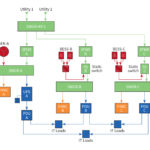A paradigm shift in data center designs
By Rajan Battish, published in EC&M Magazine
Why data center design, operations and delivery must evolve with the latest technology.

The growth of the cloud has created a boom in the data center market, touching on all aspects of the sector — including financial, corporate, medical, higher education, government and commercial. This growth is driven by the ease of data storage and the ability to access that data from anywhere. Major tech and co-location providers are scrambling to build more data centers faster, cheaper and at hyperscale.
Historically, data centers were purpose-built and designed for specific client applications, data, and reliability needs. The traditional model of building a data center in 18 to 24 months, with up to two years of additional planning, is not sustainable in the current market. Therefore, the industry needs to redefine the data center design and construction model.
Over the past several years, data center delivery has been streamlined by standardizing design, procurement, and equipment selection, while data center operations and delivery have been improved by developing metrics, such as power usage effectiveness (PUE). However, these actions are not enough; major data center components are the same as they were more than 50 years ago. Data center design, operations, and delivery must evolve with the latest technology.
CURRENT DATA CENTER MODEL
Current data centers are typically designed to Uptime Tier ratings. Various versions of these designs exist, but they essentially fall between Tier I and Tier III topologies. Tier I facilities are defined as ‘N’ capacity components and single path of power and cooling. Tier III, on the other hand, comprises concurrently maintainable systems, where a capacity component may be maintained while providing power and cooling to the computer equipment at an increased risk.
Major components of the data center electrical infrastructure are essentially the same, regardless of the tier rating, and usually include generators, uninterruptible power supplies (UPSs), switchgear, auto transfer schemes, and associated distribution equipment. The UPS provides conditioned power to the information technology (IT) equipment (compliance with IEC standards) with, typically, a power storage system to allow for back-up generators to support a longer duration of power upon loss of utility service. The on site storage can be anything from batteries, flywheels, super capacitors, etc. But when we stop and ask why, the answer is often “Because it’s what we’ve always done.”

The typical data center model for Tier III is a “3 to make 2” or “4 to make 3” distributed redundant design. The critical loading can hold up to 2.2MW of IT compute per POD of IT space. This will equate up to three UPS modules and three back-up generators with utility services as the primary power source (Fig. 1). The diesel generators could be designed for up to 72 hours of fuel storage and generally 10 to 15 minutes of battery storage for UPS systems. The 72 hours of fuel storage equates to approximately 27,000 gallons of fuel storage at rated kilowatt capacity of the generators. That is equal to approximately two gas stations at the facility.
The battery storage for the UPS is usually VRLA-type with a life expectancy of about three years (depending on power quality of service and associated battery discharges). After three years, the batteries should be replaced. If we scale this POD to a 50MW facility, that means we would need to replace the batteries on the UPS once every week. This is typical for a single facility. Imagine if you have two, three, or more facilities. Replacement of batteries would be a continuous process.
The fuel system would also need to be cleaned and maintained for eventual use by the generator. The maintenance on generator batteries and fuel systems would require constant upkeep to ensure functionality when needed. This approach for data centers worked in the past, because scale and capacity were significantly lower. Today, alternative approaches should be considered.

APPLICATION OF BATTERY TECHNOLOGY
A possible solution is to provide a battery storage system that can provide power quality that complies with IEC 62040-3 classification level 3 (Fig. 2). The approach is to remove the generator and associated UPS from a distributed redundant solution. The battery storage system can be added to incoming service points and stored outside of the building (Fig. 3). This will reduce the footprint of the building and minimize mechanical cooling. The generator parasitic losses, such as jacket water heater, fuel polishing system, and MEP systems for the building, can be eliminated by the free-standing packaged battery storage system.

Consideration should be given to either replacing a single leg of 3 to make 2, if not all three legs, depending on the site limitations and mission of the data center operations. Uptime requires 12 hours of backup on-site storage for most applications and should be considered if the data center can tolerate extended outage (beyond six to 12 hours). In addition to the mission of the data center, other factors to consider are site analysis, application redundancy, high-performance research compute, and environmental impacts.
Evaluating the electric utility system is critical in determining use of the battery energy storage system. Critical attention should be given to site utility grid reliability and power distribution systems. Typically, higher voltage provides a more reliable power system and multiple circuits with transfer schemes increases the reliability (refer to Fig. 4 from the IEEE standard). As seen in the chart, services with closed breakers (e.g., network grid) maintain a higher reliability of power; systems with a throw-over scheme have a shorter interruption duration.

IMPACT ON DESIGN AND DELIVERY
A major driver in developing a data center facility is site selection. Identifying and developing a site to accommodate initial and final expansion of the data center(s) can slow the process of permits, environmental and local ordinances because of fuel storage, noise, air permits and/or fuel burning permits, among other considerations. The battery energy storage system can simplify that process by providing pad-ready sites that can accommodate listed solutions. This plug-and-play application can simplify site planning. In addition, the construction process can be simplified, as there are fewer components to be installed and simplified controls between mechanical and electrical systems. The battery energy storage system is grid connected and “always on,” rather than open transfer to on-site backup systems.
A NEW APPROACH
The reduction in the number of components and simplified design can help reduce the electrical capital expenditure and operating costs for the facility. The utilization of a battery storage system should take into consideration various factors such as reliability of utility infrastructure, the uptime requirement of the data center, and application redundancy (synchronous/asynchronous facilities). As the need for hyperscale data centers continues to grow, the industry will look to newer, more innovative strategies to keep up with demand.



